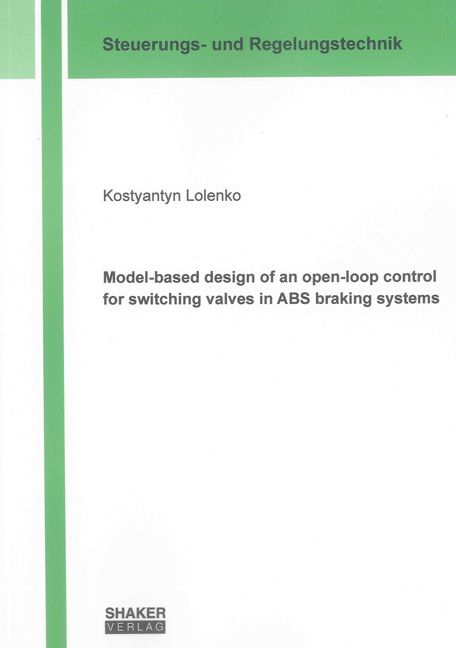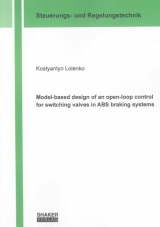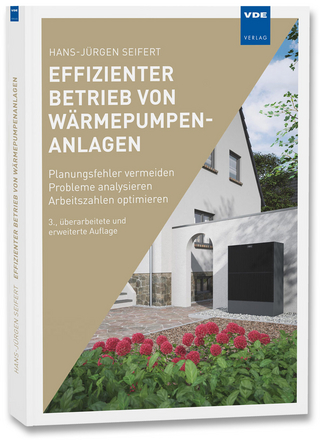Model-based design of an open-loop control for switching valves in ABS braking systems
Seiten
2011
|
1., Aufl.
Shaker (Verlag)
978-3-8440-0297-3 (ISBN)
Shaker (Verlag)
978-3-8440-0297-3 (ISBN)
- Keine Verlagsinformationen verfügbar
- Artikel merken
Antilock braking systems (ABS) significantly increase vehicle safety in critical driving situations. The main purpose of ABS consists in maintaining stability and steerability of a vehicle by control of the braking pressures.
Due to strict cost requirements most of the serial produced ABS actuators are open-loop controlled and use DC switching solenoid valves. Nevertheless, accurate control of the braking pressure is required to assure optimal performance. In addition the actuator control has to be as simple as possible to allow its serial implementation, cost effective tuning, and maintenance. This makes the design of an open-loop control for the ABS actuator a challenging problem.
The existing approaches for the design of the actuator control are empiric and do not satisfy the mentioned requirements. Therefore, this thesis provides a new model-based approach for the seamless design of the ABS actuator control. The applied method comprises following steps:
1. physical modeling of the ABS components including validation,
2. design of the actuator control using the model of the ABS components,
3. control test.
The chosen approach can be seen as an illustrative example and easily transferred to other electrohydraulic actuators.
The model-based control design premises physical modeling of the actuator components and model validation. Therefore, a detailed model of the actuator components used for simulation purposes (simulation model) and a simplified model for the control design (control design model) are derived and validated with measurements.
The only difference between the simulation and the control design model consists in mathematic description of the solenoid electromagnetics, which are of great importance for the static and dynamic behavior of the actuator. Other subsystems of the ABS actuator are described with behavioral models suitable for simulation and control design within the scope of the thesis.
The solenoid electromagnetics is seamlessly modeled on three different levels of detail: geometry (2D BEM-FEM model1), network (Detailed network model), and system (Reduced network model). The validated 2D BEM-FEM model of the electromagnetics is used as a reference for topology specification, calculation, and fitting of the parameter of the detailed network model. The reduced network model of the electromagnetics is derived by simplification of the detailed network model.
Conclusively, the simulation and the control design model are validated with measurements. The achieved results prove that the simplified model for the actuator is suitable for control design. The simulation model is appropriate for the test of the actuator control in simulation.
In the next step the open-loop control for the ABS actuator is developed based on the analysis of the control problem. The control problem for the actuator with a switching valve consists in the calculation of the control duration, i.e. how long the solenoid valve has to be switched on in order to achieve fast and accurate the desired braking pressure. The minimal control duration required to reach steady state solenoid flux has to be calculated and considered in the actuator control. The minimal switching period which gives the minimal feasible time between two successive rising edges of the control signal has to be considered too. The control duration and the physical constraints are calculated from time intervals, which characterize the dynamics of the braking pressure control.
The calculation of these characteristic time intervals is based on the equations of the control design model. For every time interval the set of the differential equations of the control design model is firstly simplified using assumptions valid for the considered time interval. Afterwards, the duration of the characteristic time interval is calculated either through symbolic integration or approximatively by applying the trapezoidal rule. The analysis of the pressure modulation dynamics by the control design provides additionally a basis for the model-based specification of the dynamic requirements for the components of the ABS actuator.
In the third step the designed open-loop control is tested by simulation. High control accuracy is proved in test with the nominal parameters of the simulation model. Afterwards, robustness of the actuator control w.r.t. variation of the actuator characteristics and estimation errors is evaluated in simulation. Deviations of the hydraulic stiffness of the caliper and the estimation error of the initial braking pressure have the strongest influence on the steady state accuracy of the actuator control. The maximal control deviations are acceptable from the point of view of the ABS without considerable affecting its function. The maximal control errors fulfill the specified criterion and are therefore acceptable. Finally, the actuator control is implemented in a serial ABS controller and tested in the vehicle experiment for different driving maneuvers. The vehicle tests prove high control accuracy required for optimal performance of the ABS and practical feasibility of the actuator control.
The designed actuator control allows an accurate realization of the desired braking pressures and is simple enough for a favorable serial implementation. Using the physical characteristics of the actuator components in the control enables its quick adjustment to different braking systems and easy maintenance. Moreover, the analytic dependency between the functional requirements to the actuator dynamics and the characteristic time intervals is derived. That allows a model-based specification of the actuator components.
Due to strict cost requirements most of the serial produced ABS actuators are open-loop controlled and use DC switching solenoid valves. Nevertheless, accurate control of the braking pressure is required to assure optimal performance. In addition the actuator control has to be as simple as possible to allow its serial implementation, cost effective tuning, and maintenance. This makes the design of an open-loop control for the ABS actuator a challenging problem.
The existing approaches for the design of the actuator control are empiric and do not satisfy the mentioned requirements. Therefore, this thesis provides a new model-based approach for the seamless design of the ABS actuator control. The applied method comprises following steps:
1. physical modeling of the ABS components including validation,
2. design of the actuator control using the model of the ABS components,
3. control test.
The chosen approach can be seen as an illustrative example and easily transferred to other electrohydraulic actuators.
The model-based control design premises physical modeling of the actuator components and model validation. Therefore, a detailed model of the actuator components used for simulation purposes (simulation model) and a simplified model for the control design (control design model) are derived and validated with measurements.
The only difference between the simulation and the control design model consists in mathematic description of the solenoid electromagnetics, which are of great importance for the static and dynamic behavior of the actuator. Other subsystems of the ABS actuator are described with behavioral models suitable for simulation and control design within the scope of the thesis.
The solenoid electromagnetics is seamlessly modeled on three different levels of detail: geometry (2D BEM-FEM model1), network (Detailed network model), and system (Reduced network model). The validated 2D BEM-FEM model of the electromagnetics is used as a reference for topology specification, calculation, and fitting of the parameter of the detailed network model. The reduced network model of the electromagnetics is derived by simplification of the detailed network model.
Conclusively, the simulation and the control design model are validated with measurements. The achieved results prove that the simplified model for the actuator is suitable for control design. The simulation model is appropriate for the test of the actuator control in simulation.
In the next step the open-loop control for the ABS actuator is developed based on the analysis of the control problem. The control problem for the actuator with a switching valve consists in the calculation of the control duration, i.e. how long the solenoid valve has to be switched on in order to achieve fast and accurate the desired braking pressure. The minimal control duration required to reach steady state solenoid flux has to be calculated and considered in the actuator control. The minimal switching period which gives the minimal feasible time between two successive rising edges of the control signal has to be considered too. The control duration and the physical constraints are calculated from time intervals, which characterize the dynamics of the braking pressure control.
The calculation of these characteristic time intervals is based on the equations of the control design model. For every time interval the set of the differential equations of the control design model is firstly simplified using assumptions valid for the considered time interval. Afterwards, the duration of the characteristic time interval is calculated either through symbolic integration or approximatively by applying the trapezoidal rule. The analysis of the pressure modulation dynamics by the control design provides additionally a basis for the model-based specification of the dynamic requirements for the components of the ABS actuator.
In the third step the designed open-loop control is tested by simulation. High control accuracy is proved in test with the nominal parameters of the simulation model. Afterwards, robustness of the actuator control w.r.t. variation of the actuator characteristics and estimation errors is evaluated in simulation. Deviations of the hydraulic stiffness of the caliper and the estimation error of the initial braking pressure have the strongest influence on the steady state accuracy of the actuator control. The maximal control deviations are acceptable from the point of view of the ABS without considerable affecting its function. The maximal control errors fulfill the specified criterion and are therefore acceptable. Finally, the actuator control is implemented in a serial ABS controller and tested in the vehicle experiment for different driving maneuvers. The vehicle tests prove high control accuracy required for optimal performance of the ABS and practical feasibility of the actuator control.
The designed actuator control allows an accurate realization of the desired braking pressures and is simple enough for a favorable serial implementation. Using the physical characteristics of the actuator components in the control enables its quick adjustment to different braking systems and easy maintenance. Moreover, the analytic dependency between the functional requirements to the actuator dynamics and the characteristic time intervals is derived. That allows a model-based specification of the actuator components.
| Erscheint lt. Verlag | 8.8.2011 |
|---|---|
| Reihe/Serie | Berichte aus der Steuerungs- und Regelungstechnik |
| Sprache | englisch |
| Maße | 170 x 240 mm |
| Gewicht | 222 g |
| Einbandart | Paperback |
| Themenwelt | Technik ► Elektrotechnik / Energietechnik |
| Schlagworte | ABS braking system • model-based design • open-loop control • seamless modeling • solenoid electromagnetics • switching valve |
| ISBN-10 | 3-8440-0297-9 / 3844002979 |
| ISBN-13 | 978-3-8440-0297-3 / 9783844002973 |
| Zustand | Neuware |
| Informationen gemäß Produktsicherheitsverordnung (GPSR) | |
| Haben Sie eine Frage zum Produkt? |
Mehr entdecken
aus dem Bereich
aus dem Bereich
Planungsfehler vermeiden – Probleme analysieren – Arbeitszahlen …
Buch | Softcover (2024)
VDE VERLAG
44,00 €




